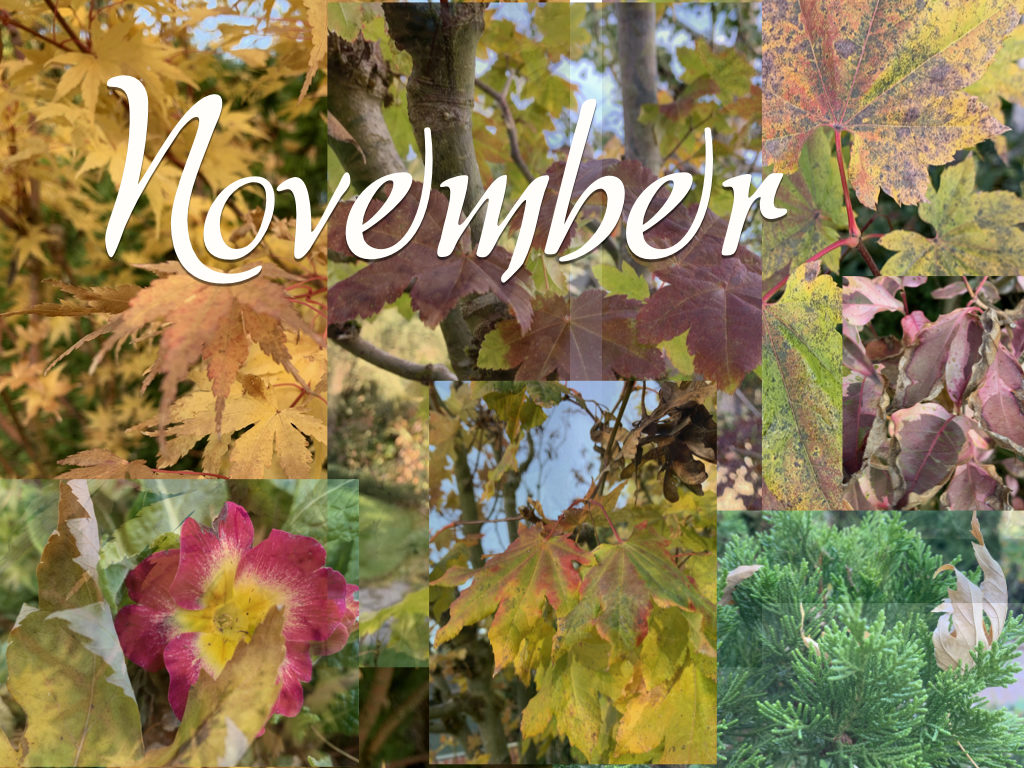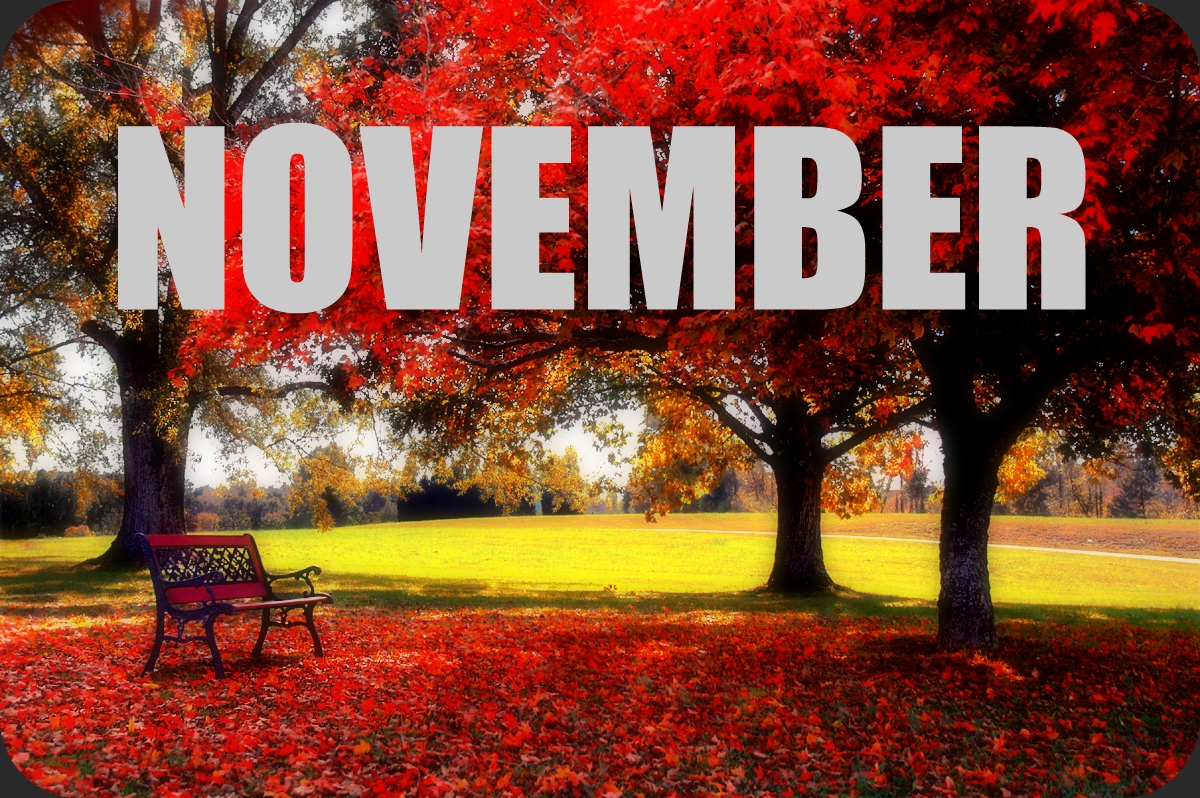
This guide is tailored for the western valleys of Oregon and Washington.
YOU can help to make the world a better, a more friendly, loving and beautiful place by being a good steward of the spot on this earth that you are privileged to be borrowing for a time—your garden. Nathan, the Treevangelist, urges you to treat your spot on this planet like your own personal Garden of Eden paradise. Then notice the joy that it will bring to you! This is your divinely mandated responsibility. Your trees, shrubs, flowers and the wildlife in your yard will express their smiling appreciation back to you and to others as they radiate love, joy and beauty bursting forth with vibrant and verdant life. Below is a to do list to help you to do just that.
November is the time when the plants in the garden are preparing themselves for long, dark and cold season as we inch our way toward winter. With the onset of colder weather, plants are slowing down their metabolic activity and tucking themselves in for their long winter snooze called winter dormancy. The flow of valuable food that is stored in the green chlorophyll of deciduous shrubs and trees is still making its trek down from the leaves and retreating into the protected woody parts of the plants and the roots where it will be stored until called upon next spring when refoliation occurs. At that time, the plants will awaken to the longer daylight of the sun’s warm and inviting rays, and they will begin their life cycle of food production and reproduction all over again. Enjoy this season as it’s time to break out the boots, scarves and wool for your outdoor ventures, and, when indoors have a bowl of hot soup for dinner as you throw another log on the fire and enjoy one of Oregon’s world class red wines!
Readers’ suggestions on how to improve this list are gladly solicited. If you, the reader, have any suggestions for additions to this month’s list, please put them in the comments section of this article, and I will add them to the list. Thank you in advance! — Nathan
Tree and Shrub Care
- Fruit tree sanitation: To prevent possible spread of leaf diseases, rake up and remove leaves from around the base of fruit trees.
- Fruit trees pruning: After the leaves drop is an excellent time to prune trees that are done fruiting and for aesthetics, since wounds will heal more quickly in warmer weather than occurs in winter. This is also a good time to reduce the height of overgrown fruit trees, since they are likely to produce fewer water sprouts now then when pruned in the spring.
- Storm proof your larger trees: Checking your trees for hazards and then take the appropriate measures to protect your trees from storm damage. If you’re not sure about the condition of your trees or even what to look for, call Good News Tree Service, Inc. for a free on-site consultation.
- Large trees: After each major weather event, check your trees for damage such as broken or hanging limbs. If you have concerns or questions about your trees, have an ISA Certified Arborist with an ISA Tree Risk Assessment Qualification (like Good News Tree Service, Inc.) inspect your large trees for damage or the potential of failure due to weak root systems and defects in trunks and branches.
- Trees—storm isssues: With the advent of winter storms and the potential damage that they may inflict upon your trees, have an ISA Certified Arborist with an ISA Tree Risk Assessment Qualification (like Good News Tree Service, Inc.) inspect your large trees for the potential of failure due to weak root systems and defects in trunks and branches. This can be done anytime of the year, but now, before the winter storms hit, is an excellent time to proactive assess the condition of your trees for potential limb and trunk breakage.
- Mulch trees and shrubs: Apply two to three inches of mulch around all trees and ornamental shrubs. This helps to fertilize the plants and feed the soil, and also protects them against weed growth and loss of water when the warmer weather returns, and helps to insulate the roots against cold weather in the winter.
- Plant or transplant trees and shrubs: After the cold, seasonal rains have started is a good time to plant or transplant ornamental trees and shrubs. Cooler weather means less transplant shock to the plants, and over the winter and spring, they will have time to begin to acclimate to their new environment before the stress of the next summer season occurs.
- Prune your trees and shrubs: This is a good time to start pruning your deciduous trees and shrubs after the leaves have fallen and a tree’s branching structure is clearly visible making pruning easier. If you’re not sure what to do, or how to do it, call Good News Tree Service, Inc. for a consultation, pruning lessons or to have them to the pruning for you.
- Prune coast/shore pines (Pinus contorta) and Scotch/Scots pines (Pinus sylvestris): These two pines are especially susceptible to the sequoia pitch moth whose larvae burrow into the tree trunks during the growing season (April through September) causing the trees to exude large amounts of unsightly pitch globules. While this seldom kills the tree, the bleeding of sap is not good for the overall health and vigor of the tree. It is advisable, therefore, not to prune these pine trees during the growing season, since the pruning cuts attract the moth, which then lays eggs on the tree, which hatch into tree-burrowing larvae. Pruning should be done on your pines from November to March.
Plant Health Care
- Arborvitae Berckmann’s Blight (Platycladus orientalis): Spray with copper twice in the fall (late Sept. and early Oct., and again in early Nov. Spray again in early spring (Feb to Mar) if disease is severe.
- Fertilize trees and shrubs: Use with a low nitrogen granular fertilizer. The fall and winter rains will slowly dissolve the fertilizer into the soil and down into the roots. Roots continue to grow throughout the winter, so it’s good to feed them for the overall health and vigor of the plant. You can also have Good News Tree Service, Inc. deep root fertilize your trees and shrubs via injection of liquid fertilizers and soil conditioners directly into the root zone of the tree through hydraulic pressure.
- Deep Root Fertilization Trees and Shrubs. If the soil temperatures permit, hire Good News Tree Service, Inc. to fertilize your ornamental shrubs and trees (via hydraulic injection) to improve their root health during the winter season and to prepare them for the upcoming spring and summer growing season. When you do this, you will notice a marked improvement in the looks of trees and shrubs.
- Magnolia Bacterial Blight: If your magnolia bush or tree has blighted leaves and flowers (dark, irregular spots) and the new shoots wilt and die in the spring, it may be magnolia bacteria blight. To treat, the magnolia needs to be sprayed once in the fall and twice in the spring near bud break.
- Verticillium wilt. Treat maples and other trees against this potentially lethal soil borne fungal pathogen. The fall is the best time to treat your plants against this disease, and spring is the second best time. Maples are especially plagued by this disease. During hot weather, symptoms include smaller than normal cupped leaves in the upper canopy, often with the death of the entire branch occurring. Maples are the hardest hit trees by this disease. Other trees susceptible to this persistent and potentially lethal fungal root disease include ash, box elder, golden rain tree, mountain ash, prunus spp. (cherry and plum), redbud, tree of heaven or silk tree, southern magnolia, tulip tree.
- Willow Twig (Bacterial) Blight: Apply copper spray fungicide after the leaves drop.
Elsewhere in the Garden
- Put slug bait around winter flowers.
- Plant spring flowering bulbs.
- Rake and dispose of ornamental tree leaves, or better yet, compost them and then spread the decomposed leaves back onto your shrub beds as a mulch next year.
- Mulch your shrub beds. Put a two to three inches of mulch (e.g. bark dust, garden compost or wood chips) around perennials and other plants that might be sensitive to subfreezing weather. Also, spread a fresh layer of mulch (e.g. bark dust, garden compost or wood chips) on all the bare dirt areas in your yard to prevent soil compaction from rains, to prevent weed growth and to enrich and help to condition your heavy clay soils. Adding a layer of mulch (several inches thick) over any tender perennial flowers, especially if the weather turns extremely cold and the ground freezes, will prevent death of flowers like dahlias.
- Winterize your irrigation system. Provide winter protection to in-ground irrigation systems by draining them and insulating valve mechanisms.
- Winterize your outdoor faucets. Protect outside faucets from subfreezing temperatures, and drain and store garden hoses in your garage or garden shed.
- Fertilize your lawn.
- Cut English ivy off of the base of trees. (This can be done any time of the year.)
- Feed the birds. Dutifully maintain your bird feeders. As winter comes, birds have a harder time finding food. Bring life and excitement to your backyard by turning it into a bird sanctuary. The birds will thank you for your generosity by providing you with hours of entertainment, and by eating insect pests that harm your ornamental trees and shrubs.

